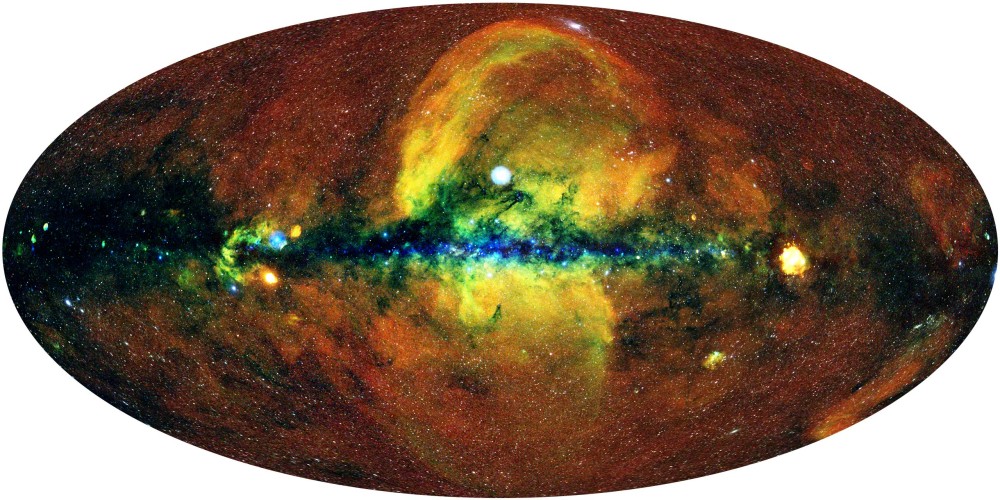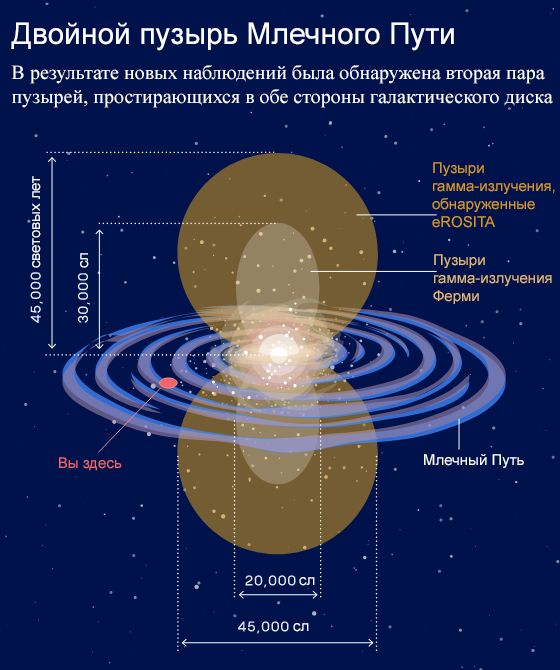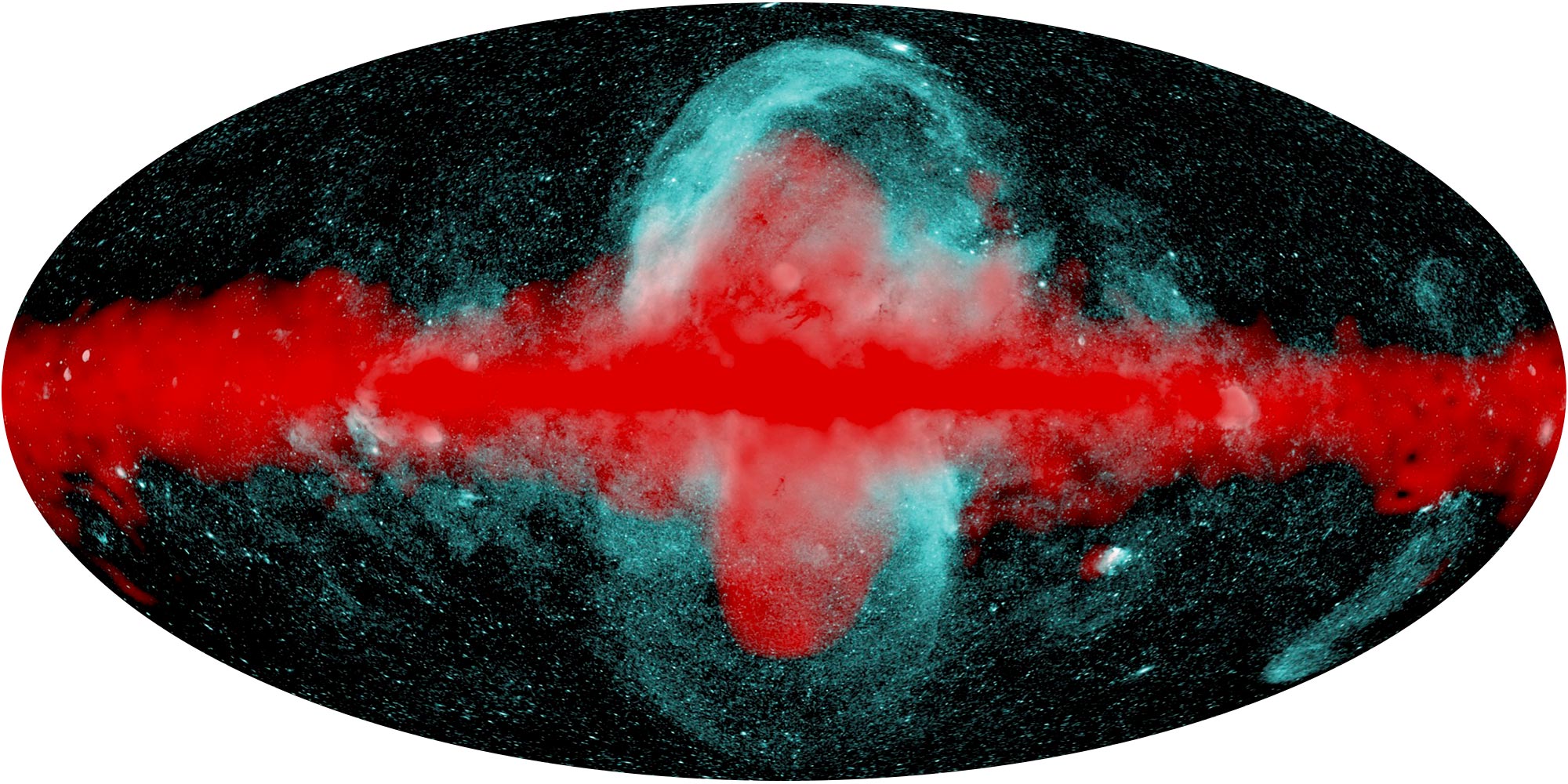For decades, astronomers have debated whether the spot in space photographs is a close-up, small object, or something huge and distant. The new X-ray star map supports the second option.

This X-ray map [clickable] clearly shows huge bubbles going up and down from the Milky Way disk. Most likely, they were generated by a supermassive black hole in the center of the Galaxy.
When Peter Limit , an astrophysicist at the Max Planck Institute for Extraterrestrial Physics in Germany, first drew attention to a new map of the hottest objects in the universe, he immediately recognized the consequences of a galactic catastrophe. The bright yellow cloud billowed tens of thousands of light-years away from the flat disk of the Milky Way, and its slightly paler counterpart reflected in the opposite direction.
The structure was so obvious that it seemed unnecessary to describe it in detail in writing. “However, Nature would not accept a one-picture publication from us, and the editor would not say something like 'Yeah, I see,'” said Limit. "So we had to do some analysis."
Published on December 9, 2020 in the journal, the results moved one idea from the field of frontier theories to the mainstream.
In the 1950s, astronomers first noticed an arch above us - "north" of the galactic plane, emitting radio beams. In the decades that followed, the "North Polar Peak" became something of a Rorschach celestial test. Some have seen the relatively closely spaced remains of a former star. Others - evidence of a massive explosion.
The contradictions arose because of the main headache of all astronomers - researchers looking into space are deprived of depth perception. "We see a two-dimensional map of a three-dimensional universe," said Kaustav Das, a researcher at the California Institute of Technology.
For several decades, astronomers believed that the North Polar Peak was part of our galactic region. Some studies have argued that it is associated with nearby gas clouds. Others, seeing how it distorts the stars in its background, and concluded that this is a supernova remnant - a dust cloud that serves as a tombstone for a dead star.
But Yoshiaki Sophue , an astronomer at the University of Tokyo, has always believed that the North Polar Peak looks too pretentious for a simple cloud of stellar remnants. He believed that this arch is part of a huge invisible structure - a pair of bubbles, covering the center of the Galaxy on both sides. In 1977 he published a simulation that peaked out digital clouds, and has since told anyone ready to listen that the peak rises tens of thousands of light-years above the disk. He described it as an expanding shockwave from a galactic disaster that happened millions of years ago.
But if Sophue was right, then a twin of this structure must also exist south of the galactic plane. But astronomers have not seen any trace of it, and most of them are not convinced by this theory.
And then in 2010 , the Fermi gamma-ray telescope capturedfaint gamma-ray emission from two huge hemispheres extending for about 20,000 years on either side of the galactic center. They were too small for the North Polar Peak, but otherwise very similar to the clouds of hot gas on the galactic scale predicted by Sophue. Astronomers wondered: if there are a couple of bubbles in the Galaxy, why shouldn't the peak be part of the second set?

"The situation changed dramatically after the discovery of Fermi bubbles," said Yun Kataoka , an astronomer at Waseda University in Japan who worked with Sofue.
The new images reinforced the change in opinions. They were taken from eROSITA, an X-ray space telescope launched in 2019 to track the effects of dark matter on galaxy clusters. The eROSITA team released a preliminary map in June. This was the result of the first six months of observation.
The map shows X-ray bubbles that have grown for about 45,000 light years, which contain Fermi gamma bubbles. It emits X-rays from a gas heated to 3-4 million Kelvin, expanding at a speed of 300-400 km / s. At the same time, the northern bubble does not just perfectly coincide with the North Polar Peak - its mirror double is perfectly visible in the photo, as Sophue predicted. “I was especially happy to see the southern bubble so similar to my simulation,” he said.
The full interpretation of all observations of the North Polar Peak is still far away - this is a difficult task, moreover, nearby supernova remnants could accidentally appear in its foreground, due to which both interpretations of the observations may turn out to be partially correct. In September, Das and his colleagues used the latest methods of observing distant stars to show that there is some kind of dust at a distance of 450 light-years - by galactic standards, just a stone's throw away.

In the composite image, where X-rays are in blue and gamma rays in red, X-ray and Fermi bubbles are clearly visible.
However, the meaning of eROSITA mushroom clouds is clear - something in the center of the Milky Way exploded very well 15-20 million years ago. Around the time when the first hyenas and martens appeared on Earth.
“I think we can end the debate for today,” said Limit, who has spent 25 years developing eROSITA.
What exploded there? Judging by the fact that these clouds turned out to be so huge and hot, there are two plausible options.
Or a wave of tens of thousands of stars appeared and exploded - something like a process going on in galaxies with bursts of star formation... However, the bubbles seem to be very clean, there are no fragments of heavy metals in them, which should have remained there in the case of exploding stars. "There are very few metals there, so I don't think this is due to a burst of stellar activity," said Kataoka [astronomers call all elements heavier than helium "metals" / approx. per.].
Or the explosion must be blamed on the supermassive black hole located in the very heart of the Galaxies. Today, this 4 million solar leviathan is relatively quiet. But if at some point a large cloud of gas got too close to it, the black hole would ignite like a searchlight. She would not only feast on hapless passers-by, but would also scatter half of its energy up and down from the plane of the disk, inflating X-ray and Fermi bubbles. Although, as Limit says, these two couples could appear at different points in time.
Astronomers have long studied galaxies that shoot jets up and down from the plane of their disks, and wondered what makes the central supermassive black holes in such galaxies behave especially aggressively. Fermi bubbles and eROSITA suggest that the main difference in behavior may simply be due to different time intervals.